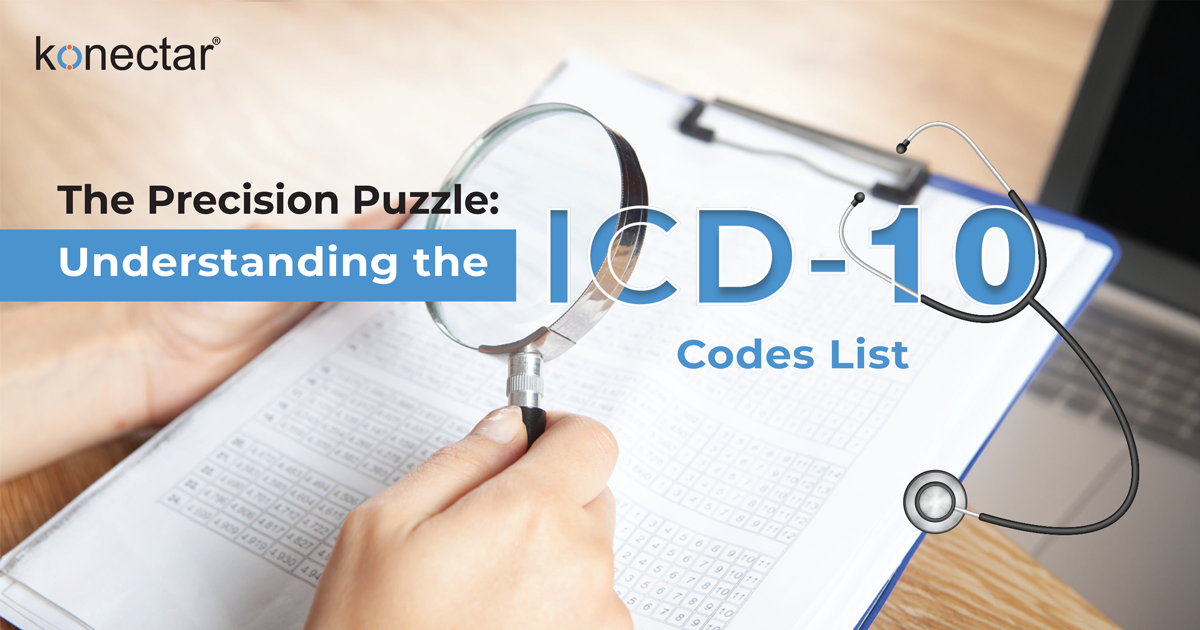The ICD-10 codes list is crucial in healthcare for the reason that it serves as a global language for categorizing diseases. This universal system ensures that the interpretation of healthcare data is consistent worldwide, making it easier for healthcare professionals, researchers, and policymakers worldwide to communicate and collaborate effectively across different healthcare settings. This article will explore what ICD 10 codes list is all about and its significance in healthcare settings.
What is the ICD-10 Codes list?
ICD-10 (International Classification of Diseases, 10th Revision) is a system of codes used by healthcare providers and practitioners to classify and code various diseases, conditions, and medical procedures. It is used for billing, statistical, research and Medical Claim purposes. It comprises two distinct sets of codes: ICD-10-CM, Clinical Modification, and ICD-10-PCS, Procedure Coding System. These codes went live in 2015.
The United States adopted the ICD-10 by developing a Clinical Modification (ICD-10-CM) for medical diagnoses, building upon the framework provided by the World Health Organization's ICD-10. The CMS (Centers for Medicare & Medicaid Services ) also formulated a distinct Procedure Coding System known as ICD-10-PCS, designed explicitly for inpatient procedures.
The complete code list for ICD-10 is quite extensive and covers a wide range of medical conditions. It includes over 68000 codes covering various diseases, injuries, external causes of injuries, and more. For instance, the ICD 10 mental health codes list ranges from F01-F99 and covers diverse mental health conditions, whereas the list of hypertension ICD-10 codes is limited and spans from I10 to I15.
ICD-10-CM was created and managed by WHO (World Health Organization) and NCHS (the National Center for Health Statistics), which operates under the Centers for Disease Control and Prevention. It is complemented by official guidelines and mandated by the HIPAA "medical data code set" regulations. The CDC reviews and revises these guidelines on an annual basis. It is crucial to utilize the codes and guidelines aligned with the specific year in which the healthcare service is provided.
The structure of ICD-10 coding
ICD-10-CM codes are composed of three to seven characters, with each code starting with an alpha character that signifies the relevant chapter. The second and third characters are numerical, while the following characters (fourth through seventh) can be either numbers or letters. Below are instances of the codes alongside the corresponding conditions they denote.For, e.g., C50.512: Malignant neoplasm of the lower-outer quadrant of left female breast
Factors to Consider for accurate ICD-10 coding
The ICD-10-CM and the official guidelines can be accessed through the CMS website. This page has a link to various resources, including a ZIP file containing the code table and index. It is important to ensure that the codes downloaded correspond to the correct year during which the services are rendered.
To start with, one needs to access two sets of lists for accurate coding. The Alphabetical Index of diagnostic terms and their corresponding codes list numerous main terms alphabetically. AAO (the American Academy of Ophthalmology) has outlined the following five-step process for accurate coding:
-
Step 1
Search the Alphabetical Index for the diagnostic term. Note the associated code.
Tip: The term may not be a main term in the index but might be listed under one. For example, "Congenital cataract" is listed under "Cataract."
-
Step 2
Check the Tabular List. Before using the code from the Alphabetical Index, verify it in the Tabular List for any special instructions.
-
Step 3
Read the code's instructions in the Tabular List. It provides all the necessary diagnosis code requirements.
-
Step 4
For an injury or trauma, you must add a seventh character (A for initial encounter, D for subsequent encounter, S for sequela).
-
Step 5
For conditions such as glaucoma, add a seventh character for staging (0 for unspecified, 1 for mild, 2 for moderate, 3 for severe, and 4 for indeterminate).
Always code with the highest accuracy and completeness, using all available digits.
How ICD-10 Enhances Precision and Detail in Healthcare

This coding system allows for more efficient tracking of healthcare trends while addressing quality concerns and facilitating evaluations of health outcomes. It is better and more detailed than ICD-9-CM and hence allows for more precise identification of health conditions. This improvement enhances data accuracy for evaluating healthcare utilization and patient care quality.
The new code sets provide more detailed information, including laterality, severity, and complexity of disease conditions, ensuring accurate identification and monitoring of specific health issues. Terminology and disease classification align with current technology and clinical practices.
The code list also provides detailed insights into injuries, poisonings, and external causes, including severity and specific details about how and where injuries occurred. In the pregnancy, delivery, and puerperium chapter, ICD-10-CM codes specify the pregnancy trimester, offering more detailed information about maternal health.
The ICD-10-CM postoperative codes differentiate between intraoperative and post-procedural complications, providing a more nuanced understanding of patient outcomes. It also introduces new concepts like under-dosing, blood type, the Glasgow Coma Scale, and alcohol levels, reflecting advancements in medical knowledge and practices. Since different medical specialties may have specific considerations, accurate code identification is crucial.
Staying informed and adapting to ICD-10 coding changes
This new coding list is regularly updated to reflect new medical knowledge and changes in healthcare practices. Adapting to these changes is essential to represent patients' diagnoses and treatments accurately. Also, being on top of coding changes has significant benefits, such as avoiding coding mistakes that could impact payment and Patient Care. Accurate coding is also important as it ensures that reported data is reliable, contributing to a more effective healthcare system.
-
What are ICD-10 codes, and why are they significant in healthcare?
These are alphanumeric codes used to classify diseases, conditions, and medical procedures. They are used in healthcare for standardized documentation, billing, and statistical analysis.
-
What improvements does the ICD-10 codes list offer over its predecessor, ICD-9?
The ICD-10 codes list provides more detailed and specific codes. It accommodates medical knowledge and technology advancements, helping Healthcare Professionals with better diagnosis, treatment, and billing.
-
How are ICD-10 codes structured, and what do the alphanumeric components signify?
Each of these codes has three to seven alphanumeric characters. Each component conveys specific information. The first three characters represent the category, and the following characters indicate the etiology, anatomical site, severity, and other details.
ICD-10 codes are significant in healthcare as they provide a standardized way to categorize diseases and procedures globally. These codes have also improved the precision of healthcare documentation and contributed to better billing, data analysis, and overall patient care. Adapting to this coding system ensures healthcare professionals are equipped for excellence in delivering quality healthcare.



